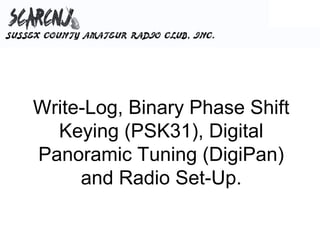
Binary phase shift_keying
- 1. Write-Log, Binary Phase Shift Keying (PSK31), Digital Panoramic Tuning (DigiPan) and Radio Set-Up.
- 2. Write-Log Click her to open this box. Set the frequency and mode before operating. Click FSK for PSK-31 Contacts. Please try not to forget to avoid unnecessary editing.
- 3. Write-Log Super Check Partial Click Window Click Window then then Super Check Partial Band Summary. Networking will display all Stations. Click Contest then Multipliers Logged Stations Enter Call, Operating Class and Section. Tab over by using Space Bar “Alt W” Clears this entire row. Left, Right Arrows and Backspace allows for editing.
- 4. What is PSK31? • PSK31 was developed by Peter Martinez (G3PLX) and introduced to the amateur community in December 1998. • PSK31 was also known as Varicode Mode (Variable Number of Bits) • From the perspective of the transmitter, this amounts to little more than somebody whistling into the microphone. • PSK31 rapidly shifts the phase of the audio signal between two states. These shifts serve the same function as two FSK tones traditionally used by RTTY. Instead of shifting frequency we’re shifting phase. • PSK31's bandwidth of 31.25 Hz was chosen because a normal typing speed of about 50 words per minute requires a bit rate of about 32 bits per second (1Bit/Hz). • PSK31’s 31.25 Hz can be derived from the 8 KHz sample rate used by the DSP chips in computer sound cards
- 5. What is PSK31? BIT Value Amount of Degrees of Shift Shift 0 None 00 1 1/2 1800 Time Domain Frequency Domain
- 6. PSK 31 vs. RTTY • The chart at the right shows the BIT Error Rate (BER) as a 1 function of Signal-to-Noise ratio in a noiseless 0.1 environment. 0.01 RTTY • Note: BER is the number of BIT’s 3 1 .10 received in error. For example, a BER of 10-5 is 1 erroneous BIT 1 .10 4 received in error out of 100,000. Bit Error Rate 5 1 .10 • For Signal-to-Noise (S/N) PSK-31 PSK-31 ratios greater than 10 dB, 1 .10 6 PSK-31 is virtually error free. 1 .10 7 • S/N=10Log(Power of the Signal ÷ 8 1 .10 Power of the Noise). In other terms, if the noise level is 1uV 1 .10 9 QPSK-31 then you need 3.16uV for 10dB S/N 1 .10 10 0 5 10 15 20 • At poor S/N ratios the BER of PSK-31 is five times better Signal-to-Noise Ratio (dB) than RTTY • Note the curve that represents QPSK-31.
- 7. PSK31 - Real World Performance • The power in a PSK-31 signal is concentrated in a 31.25 Hz bandwidth versus 250 Hz (BW not frequency shift) for RTTY and 3300 Hz for SSB. • Assuming 100 watts of transmit power, the PSK-31 signal has 3.2 watts/Hz vs. 30mW/Hz for SSB. • If a signal provides 20 dB S/N ratio at the receiver using SSB, the same S/N ratio is achieved with 8W using RTTY and only 1W using PSK-31! • Lower Case characters are more efficient than upper case due to Varicode (not to be confused with ASCII or Binary code). PSK31 characters contain a variable number of bits. • Lower-case PSK31 characters have fewer bits than their upper-case equivalents, so lower-case text transmits faster and decodes better • For example, the letter “a” has the Varicode 1011. The capital letter “A” has a Varicode of 1111101. – The letter “a” has four BIT’s
- 8. FYI: The better alternative QPSK31 • QPSK31 has FEC convolutional code; lowers the number of errors • Forward Error Correction (FEC) is when redundant data is sent 900 out of phase with the primary data stream. • A Viterbi Decoder decodes the bit stream and estimates likelihood the data is correct or not. If not it corrects the error. • Under very poor propagation conditions (like now); 1 out of 5 PSK-31 characters get thru compared to 1 out of 2 QPSK-31 characters.
- 9. DigiPan – Signal Channel This is the Receive Window Right Click to put cursor on the signal you want to receive. This is the Transmit Window
- 10. Preset FD Macro's DigiPan – Multichannel 3A NNJ Click Call Goes here CQ IMD
- 11. Radio Set Up • PSK-31 is a 100% duty cycle mode. For all radio’s reduce power by 50% • Turn Audio Compression OFF • With MIC Gain very low and power very low click T/R button on DigiPan to Transmit • Adjust MIC gain so ALC has little or no needle movement – This is to prevent Inter-Modulation Distortion from being transmitted. Digital waveforms inherently produce IMD’s. • Adjust power to ~50W (typical). • Re-adjust MIC gain for little or no ALC needle movement • Re-adjust power output. • Click T/R again to go back to Receive • You can operate any mode that you please; SSB, CW or PSK-31. All three HF stations will have full three mode capability. • If you don’t know ASK!!! Don’t guess!!!
